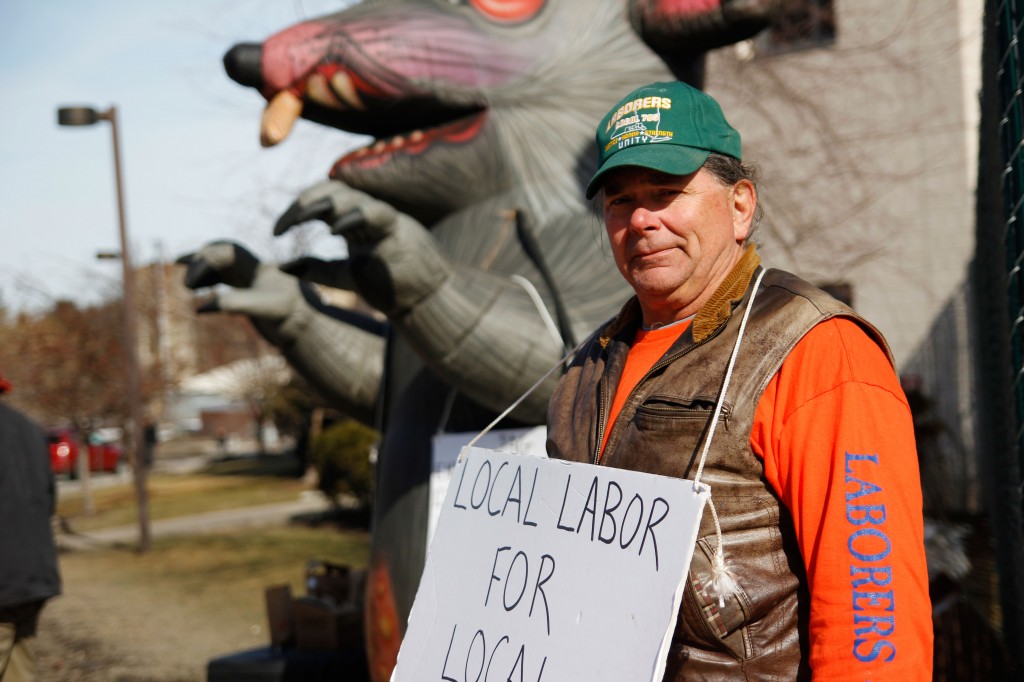
Walking or driving past Lecture Hall last week, students were greeted by an uncommon sight for the Brain — a giant, inflatable rat.
The inflatable rat, or “union rat,” is used by protesting or striking trade unions against their employers or companies using non-union labor. According to David Marsh, the business manager for construction union Laborers Local 785, that is the situation for construction on Lecture Hall.
“We’re protesting the contractor out of Syracuse that’s using out-of-town labor,” Marsh said. “We tried to work with them, and they won’t hire any local labor on this job. Here in Broome County we have 40 people out of work, so we really want to get a piece of it. It’s a big project, $12 million, and their portion of the project is 16 weeks of work. So it would really help our folks.”
Laborers Local 785 is a union that encompasses Broome, Tioga and Chemung counties, and parts of nine more in the Southern Tier and Finger Lakes. Members picketed in front of the construction site on Wednesday, Thursday and Friday, holding up signs and handing out literature to passersby.
JAG Environmental, a non-union contractor based in Syracuse, is conducting the Lecture Hall asbestos abatement and demolition work. Ryan Yarosh, director of media and public relations at Binghamton University, said the contractor was chosen by the State University Construction Fund which is controlled by SUNY, not BU. He said the construction contract is legally mandated to be awarded to the least expensive qualified bidder, regardless of union membership.
“While the asbestos contractor for the Lecture Hall Classroom Wing project may be using non-union labor, many other contractors for this project will involve union labor,” Yarosh wrote in an email. “It’s important to note too that in some instances, the local union hall may not have workers that have a certain skill set or are certified to perform certain work.”
However, Marsh said his members were qualified, and stressed the importance of using local labor, and that it is commonplace for them to work with state colleges. Cornell, he said, has signed an agreement to use as much as legally possible, though it operates under different rules as it is a private college. He also said JAG had initially promised to work with 785 when they began the project.
Marsh said the job could provide Broome County residents with anywhere from 15 to 50 jobs, which was important in light of a recent dry spell of work.
“I just hope people value the need to use local labor,” Marsh said. “The University is the largest employer in the community, and should value the use of local labor, and try to do their best to make sure that happens. The University can really apply influence here and make sure the projects are under labor agreements.”
Pipe Dream reached out to JAG Environmental for comment, but did not receive a response.
James Weyrauch, executive board member of Laborers Local 785 and a labor steward, said using local unions for construction was not only important because it sets precedent for future projects, but also because of how it impacts the local economy.
“When local people go to work, they spend money locally,” Weyrauch said. “When non-union guys come in here, from out of area, they take it back home and spend money in their area. It’s extremely common for state schools to use union contractors, here and all over the country. But more frequently contractors are bringing non-labor workers and we want to prevent that.”
Marsh said feedback from students and faculty has been positive so far. Rachel Lecker, a junior majoring in graphic design, said she hoped to see the laborers put back into work.
“I was so confused when I saw these people out here, but I’m glad they are,” Lecker said. “The University is such a huge part of the community, I think it’s only fair we try to include them when we do big projects like this. We take so much from the community, we should give back any way we can.”


